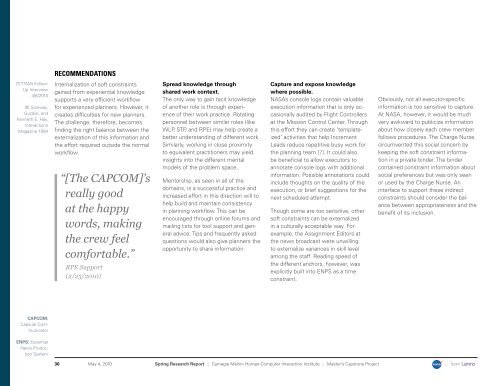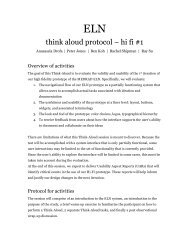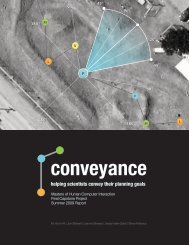Spring Report - Human-Computer Interaction Institute - Carnegie ...
Spring Report - Human-Computer Interaction Institute - Carnegie ...
Spring Report - Human-Computer Interaction Institute - Carnegie ...
Create successful ePaper yourself
Turn your PDF publications into a flip-book with our unique Google optimized e-Paper software.
Recommendations<br />
[7] TITAN Follow-<br />
Up Interview<br />
4/6/2010<br />
[8] Soloway,<br />
Guzdial, and<br />
Kenneth E. Hay,<br />
<strong>Interaction</strong>s<br />
Magazine 1994<br />
Internalization of soft constraints<br />
gained from experiential knowledge<br />
supports a very efficient workflow<br />
for experienced planners. However, it<br />
creates difficulties for new planners.<br />
The challenge, therefore, becomes<br />
finding the right balance between the<br />
externalization of this information and<br />
the effort required outside the normal<br />
workflow.<br />
“[The CAPCOM]’s<br />
really good<br />
at the happy<br />
words, making<br />
the crew feel<br />
comfortable.”<br />
RPE Support<br />
(2/23/2010)<br />
Spread knowledge through<br />
shared work context.<br />
The only way to gain tacit knowledge<br />
of another role is through experience<br />
of their work practice. Rotating<br />
personnel between similar roles (like<br />
WLP, STP, and RPE) may help create a<br />
better understanding of different work.<br />
Similarly, working in close proximity<br />
to equivalent practitioners may yield<br />
insights into the different mental<br />
models of the problem space.<br />
Mentorship, as seen in all of the<br />
domains, is a successful practice and<br />
increased effort in this direction will to<br />
help build and maintain consistency<br />
in planning workflow. This can be<br />
encouraged through online forums and<br />
mailing lists for tool support and general<br />
advice. Tips and frequently asked<br />
questions would also give planners the<br />
opportunity to share information.<br />
Capture and expose knowledge<br />
where possible.<br />
NASA’s console logs contain valuable<br />
execution information that is only occasionally<br />
audited by Flight Controllers<br />
at the Mission Control Center. Through<br />
this effort they can create ‘templateized’<br />
activities that help Increment<br />
Leads reduce repetitive busy work for<br />
the planning team [7]. It could also<br />
be beneficial to allow executors to<br />
annotate console logs with additional<br />
information. Possible annotations could<br />
include thoughts on the quality of the<br />
execution, or brief suggestions for the<br />
next scheduled attempt.<br />
Though some are too sensitive, other<br />
soft constraints can be externalized<br />
in a culturally acceptable way. For<br />
example, the Assignment Editors at<br />
the news broadcast were unwilling<br />
to externalize variances in skill level<br />
among the staff. Reading speed of<br />
the different anchors, however, was<br />
explicitly built into ENPS as a time<br />
constraint.<br />
Obviously, not all executor-specific<br />
information is too sensitive to capture.<br />
At NASA, however, it would be much<br />
very awkward to publicize information<br />
about how closely each crew member<br />
follows procedures. The Charge Nurse<br />
circumvented this social concern by<br />
keeping the soft constraint information<br />
in a private binder. The binder<br />
contained constraint information about<br />
social preferences but was only seen<br />
or used by the Charge Nurse. An<br />
interface to support these indirect<br />
constraints should consider the balance<br />
between appropriateness and the<br />
benefit of its inclusion.<br />
Offer contextual help to novices.<br />
Scaffolding is a technique that teachers<br />
use to provide support to learners of a<br />
new task. As a student gains expertise,<br />
a good teacher provides less and less<br />
coaching. Thus, the scaffolding fades<br />
as the learner becomes more experienced<br />
and is ready to be in full control<br />
[8]. Planners at NASA could use this<br />
technique to reduce the learning curve<br />
of new technologies and save training<br />
costs. There is an opportunity to<br />
incorporate unique indirect constraints<br />
for novices by building tips about how<br />
to handle frequent problems and suggestions<br />
for next steps in editing the<br />
plan. These tips could come directly<br />
from the expert’s hands. Experiential<br />
knowledge comes into play by learning<br />
from the past mistakes of others<br />
and benefitting from previous plans,<br />
which is something that no system did<br />
especially well.<br />
CAPCOM:<br />
Capsule Communicator<br />
Jenn and Noah observing Short-Term Planners (STP) having an impromptu discussion about the schedule.<br />
ENPS: Essential<br />
News Production<br />
System<br />
30 May 4, 2010 <strong>Spring</strong> Research <strong>Report</strong> :: <strong>Carnegie</strong> Mellon <strong>Human</strong>-<strong>Computer</strong> <strong>Interaction</strong> <strong>Institute</strong> :: Master’s Capstone Project :: Team Lumina Team Lumina :: <strong>Spring</strong> Research <strong>Report</strong> :: <strong>Carnegie</strong> Mellon <strong>Human</strong>-<strong>Computer</strong> <strong>Interaction</strong> <strong>Institute</strong> :: Master’s Capstone Project May 4, 2010 31







